Management Accounting Report: Cost Analysis, Variance, and Budgeting
VerifiedAdded on 2020/01/23
|17
|5403
|31
Report
AI Summary
This report delves into the realm of management accounting, focusing on its application within Jeffrey & Son's, a manufacturing company producing Exquisite products. The report begins with an introduction to management accounting, highlighting its significance in strategic decision-making and organizational success. It then proceeds to analyze various cost classifications, including elements, functions, nature, and behavior. Furthermore, the report calculates job costs using the job costing method and determines exquisite costs through absorption costing techniques. It also analyzes cost data, prepares cost reports, and determines variances. The report covers the budgeting process, including the preparation of production, material purchase, and cash budgets. Finally, it identifies variances, their causes, and the actions needed to correct them, culminating in an operating statement that combines budgeted and actual results, and reports the findings to management, in accordance with responsibility centers.
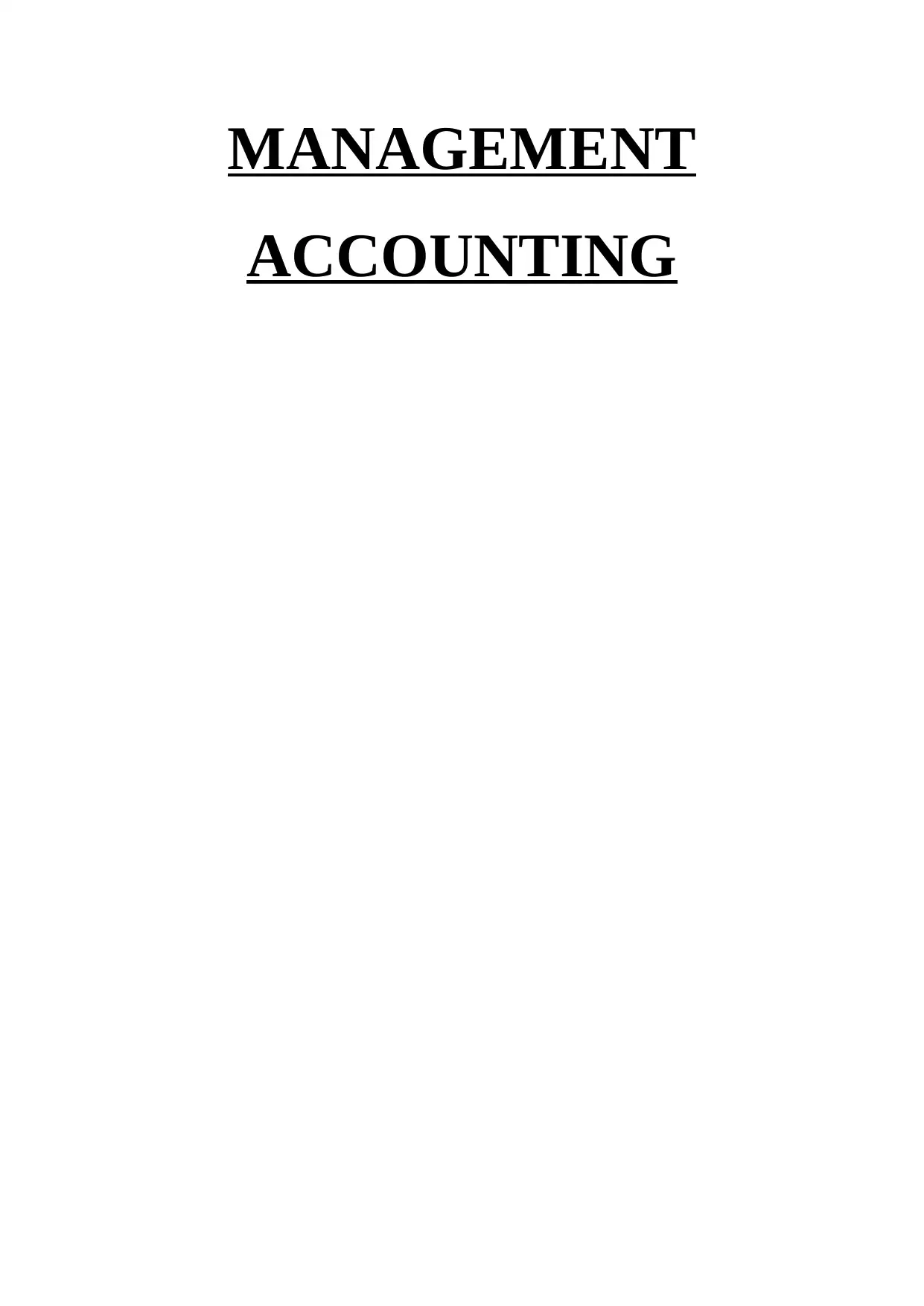
MANAGEMENT
ACCOUNTING
ACCOUNTING
Paraphrase This Document
Need a fresh take? Get an instant paraphrase of this document with our AI Paraphraser
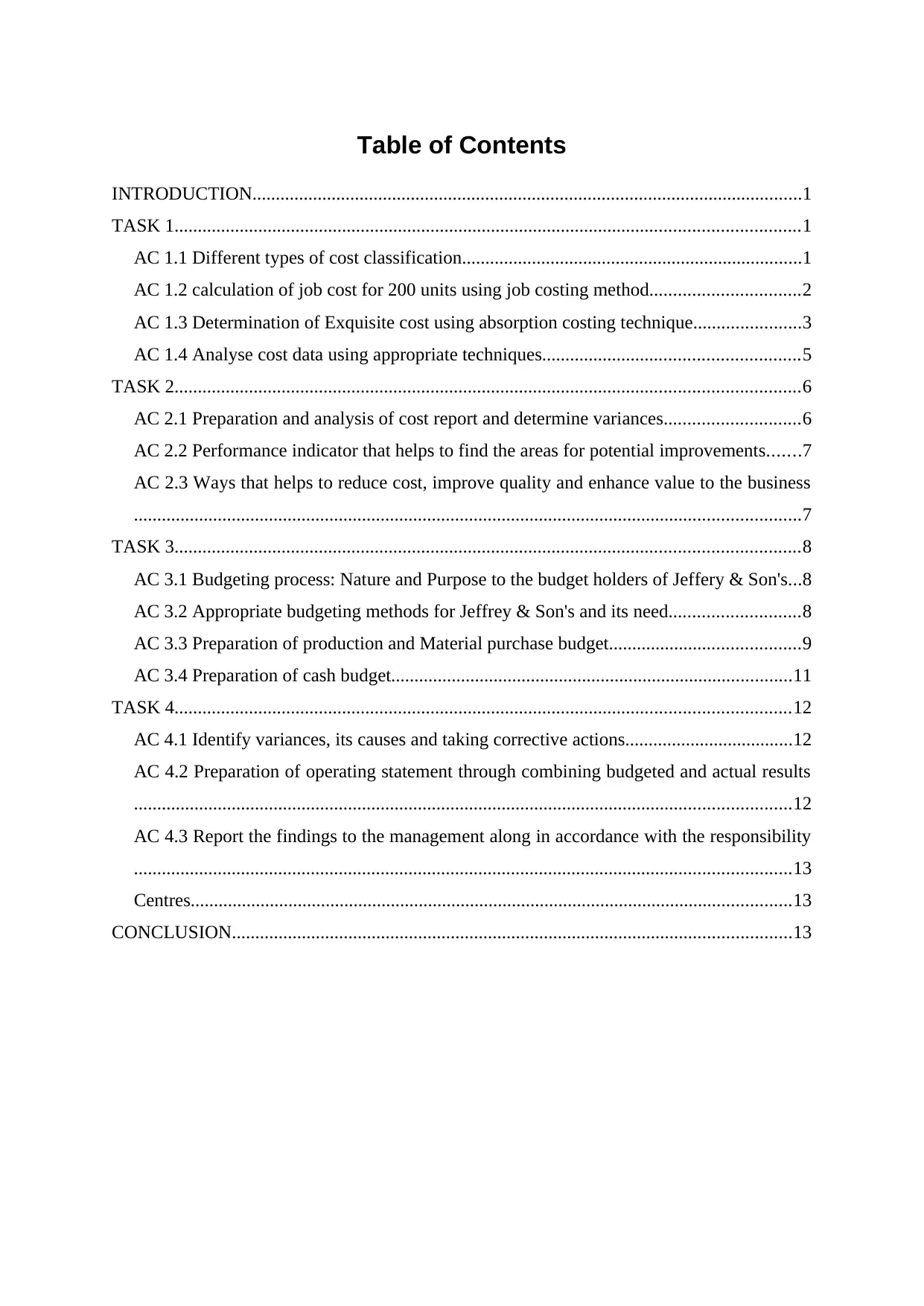
Table of Contents
INTRODUCTION......................................................................................................................1
TASK 1......................................................................................................................................1
AC 1.1 Different types of cost classification.........................................................................1
AC 1.2 calculation of job cost for 200 units using job costing method................................2
AC 1.3 Determination of Exquisite cost using absorption costing technique.......................3
AC 1.4 Analyse cost data using appropriate techniques.......................................................5
TASK 2......................................................................................................................................6
AC 2.1 Preparation and analysis of cost report and determine variances.............................6
AC 2.2 Performance indicator that helps to find the areas for potential improvements.......7
AC 2.3 Ways that helps to reduce cost, improve quality and enhance value to the business
...............................................................................................................................................7
TASK 3......................................................................................................................................8
AC 3.1 Budgeting process: Nature and Purpose to the budget holders of Jeffery & Son's...8
AC 3.2 Appropriate budgeting methods for Jeffrey & Son's and its need............................8
AC 3.3 Preparation of production and Material purchase budget.........................................9
AC 3.4 Preparation of cash budget......................................................................................11
TASK 4....................................................................................................................................12
AC 4.1 Identify variances, its causes and taking corrective actions....................................12
AC 4.2 Preparation of operating statement through combining budgeted and actual results
.............................................................................................................................................12
AC 4.3 Report the findings to the management along in accordance with the responsibility
.............................................................................................................................................13
Centres.................................................................................................................................13
CONCLUSION........................................................................................................................13
INTRODUCTION......................................................................................................................1
TASK 1......................................................................................................................................1
AC 1.1 Different types of cost classification.........................................................................1
AC 1.2 calculation of job cost for 200 units using job costing method................................2
AC 1.3 Determination of Exquisite cost using absorption costing technique.......................3
AC 1.4 Analyse cost data using appropriate techniques.......................................................5
TASK 2......................................................................................................................................6
AC 2.1 Preparation and analysis of cost report and determine variances.............................6
AC 2.2 Performance indicator that helps to find the areas for potential improvements.......7
AC 2.3 Ways that helps to reduce cost, improve quality and enhance value to the business
...............................................................................................................................................7
TASK 3......................................................................................................................................8
AC 3.1 Budgeting process: Nature and Purpose to the budget holders of Jeffery & Son's...8
AC 3.2 Appropriate budgeting methods for Jeffrey & Son's and its need............................8
AC 3.3 Preparation of production and Material purchase budget.........................................9
AC 3.4 Preparation of cash budget......................................................................................11
TASK 4....................................................................................................................................12
AC 4.1 Identify variances, its causes and taking corrective actions....................................12
AC 4.2 Preparation of operating statement through combining budgeted and actual results
.............................................................................................................................................12
AC 4.3 Report the findings to the management along in accordance with the responsibility
.............................................................................................................................................13
Centres.................................................................................................................................13
CONCLUSION........................................................................................................................13
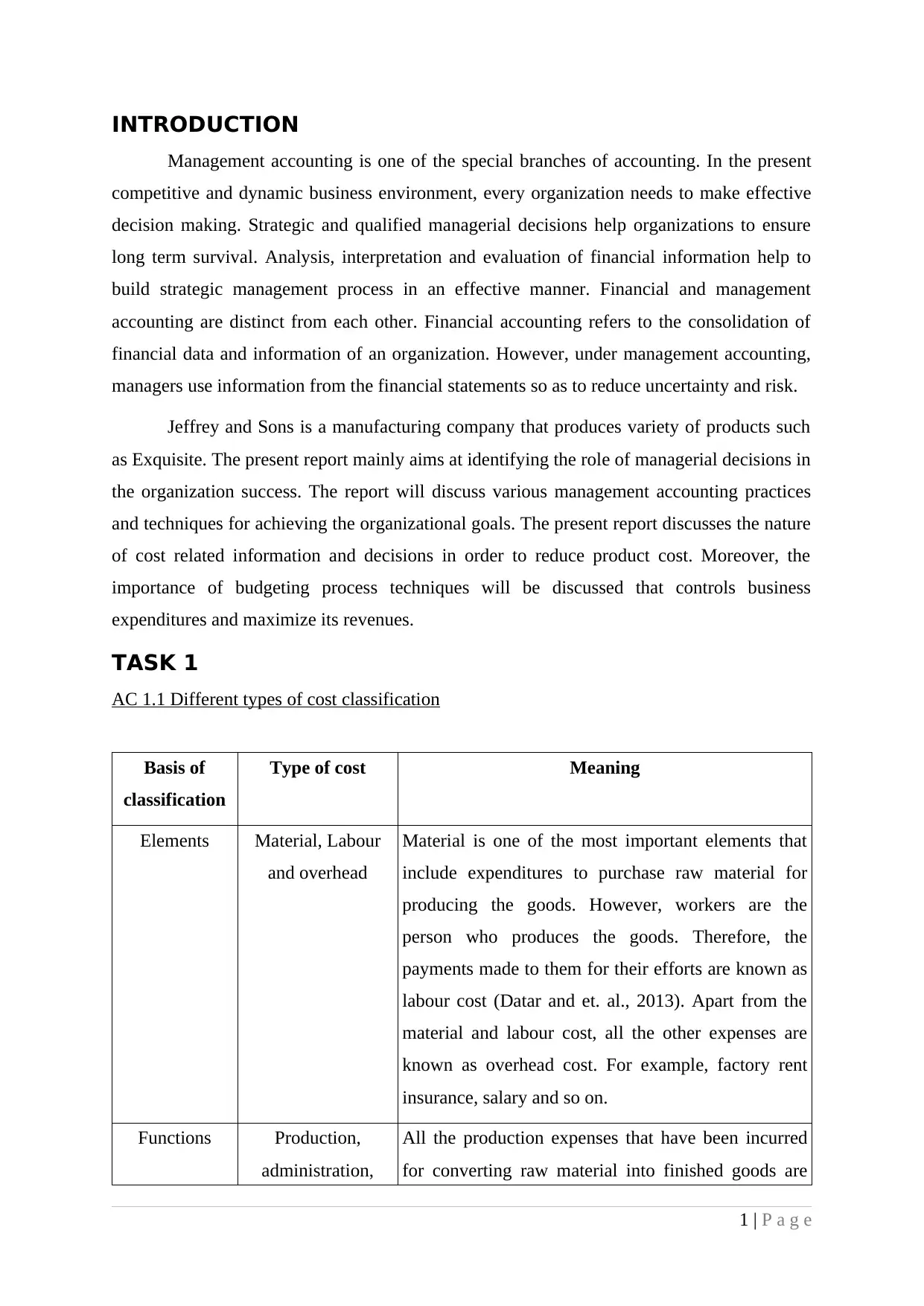
INTRODUCTION
Management accounting is one of the special branches of accounting. In the present
competitive and dynamic business environment, every organization needs to make effective
decision making. Strategic and qualified managerial decisions help organizations to ensure
long term survival. Analysis, interpretation and evaluation of financial information help to
build strategic management process in an effective manner. Financial and management
accounting are distinct from each other. Financial accounting refers to the consolidation of
financial data and information of an organization. However, under management accounting,
managers use information from the financial statements so as to reduce uncertainty and risk.
Jeffrey and Sons is a manufacturing company that produces variety of products such
as Exquisite. The present report mainly aims at identifying the role of managerial decisions in
the organization success. The report will discuss various management accounting practices
and techniques for achieving the organizational goals. The present report discusses the nature
of cost related information and decisions in order to reduce product cost. Moreover, the
importance of budgeting process techniques will be discussed that controls business
expenditures and maximize its revenues.
TASK 1
AC 1.1 Different types of cost classification
Basis of
classification
Type of cost Meaning
Elements Material, Labour
and overhead
Material is one of the most important elements that
include expenditures to purchase raw material for
producing the goods. However, workers are the
person who produces the goods. Therefore, the
payments made to them for their efforts are known as
labour cost (Datar and et. al., 2013). Apart from the
material and labour cost, all the other expenses are
known as overhead cost. For example, factory rent
insurance, salary and so on.
Functions Production,
administration,
All the production expenses that have been incurred
for converting raw material into finished goods are
1 | P a g e
Management accounting is one of the special branches of accounting. In the present
competitive and dynamic business environment, every organization needs to make effective
decision making. Strategic and qualified managerial decisions help organizations to ensure
long term survival. Analysis, interpretation and evaluation of financial information help to
build strategic management process in an effective manner. Financial and management
accounting are distinct from each other. Financial accounting refers to the consolidation of
financial data and information of an organization. However, under management accounting,
managers use information from the financial statements so as to reduce uncertainty and risk.
Jeffrey and Sons is a manufacturing company that produces variety of products such
as Exquisite. The present report mainly aims at identifying the role of managerial decisions in
the organization success. The report will discuss various management accounting practices
and techniques for achieving the organizational goals. The present report discusses the nature
of cost related information and decisions in order to reduce product cost. Moreover, the
importance of budgeting process techniques will be discussed that controls business
expenditures and maximize its revenues.
TASK 1
AC 1.1 Different types of cost classification
Basis of
classification
Type of cost Meaning
Elements Material, Labour
and overhead
Material is one of the most important elements that
include expenditures to purchase raw material for
producing the goods. However, workers are the
person who produces the goods. Therefore, the
payments made to them for their efforts are known as
labour cost (Datar and et. al., 2013). Apart from the
material and labour cost, all the other expenses are
known as overhead cost. For example, factory rent
insurance, salary and so on.
Functions Production,
administration,
All the production expenses that have been incurred
for converting raw material into finished goods are
1 | P a g e
⊘ This is a preview!⊘
Do you want full access?
Subscribe today to unlock all pages.

Trusted by 1+ million students worldwide
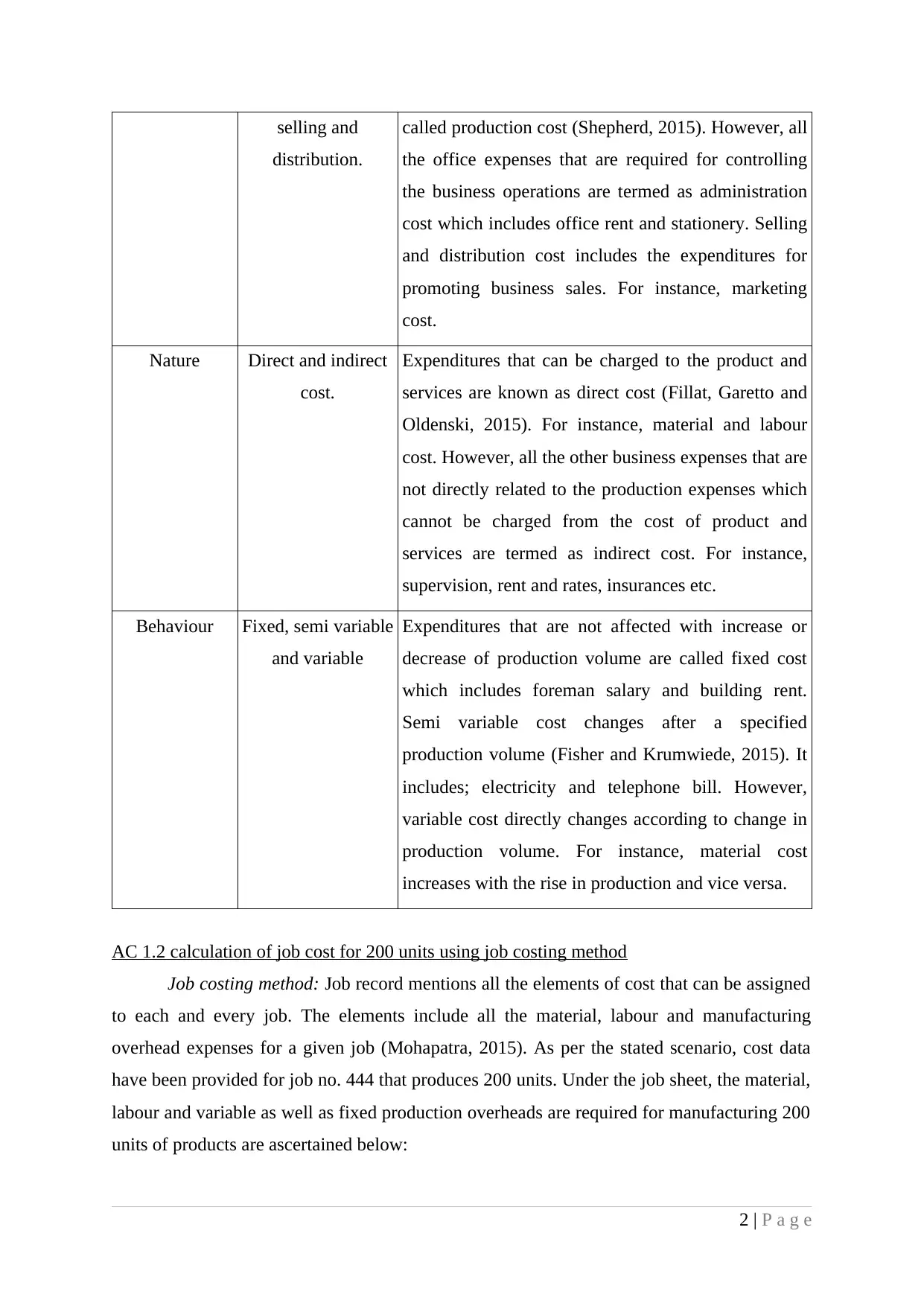
selling and
distribution.
called production cost (Shepherd, 2015). However, all
the office expenses that are required for controlling
the business operations are termed as administration
cost which includes office rent and stationery. Selling
and distribution cost includes the expenditures for
promoting business sales. For instance, marketing
cost.
Nature Direct and indirect
cost.
Expenditures that can be charged to the product and
services are known as direct cost (Fillat, Garetto and
Oldenski, 2015). For instance, material and labour
cost. However, all the other business expenses that are
not directly related to the production expenses which
cannot be charged from the cost of product and
services are termed as indirect cost. For instance,
supervision, rent and rates, insurances etc.
Behaviour Fixed, semi variable
and variable
Expenditures that are not affected with increase or
decrease of production volume are called fixed cost
which includes foreman salary and building rent.
Semi variable cost changes after a specified
production volume (Fisher and Krumwiede, 2015). It
includes; electricity and telephone bill. However,
variable cost directly changes according to change in
production volume. For instance, material cost
increases with the rise in production and vice versa.
AC 1.2 calculation of job cost for 200 units using job costing method
Job costing method: Job record mentions all the elements of cost that can be assigned
to each and every job. The elements include all the material, labour and manufacturing
overhead expenses for a given job (Mohapatra, 2015). As per the stated scenario, cost data
have been provided for job no. 444 that produces 200 units. Under the job sheet, the material,
labour and variable as well as fixed production overheads are required for manufacturing 200
units of products are ascertained below:
2 | P a g e
distribution.
called production cost (Shepherd, 2015). However, all
the office expenses that are required for controlling
the business operations are termed as administration
cost which includes office rent and stationery. Selling
and distribution cost includes the expenditures for
promoting business sales. For instance, marketing
cost.
Nature Direct and indirect
cost.
Expenditures that can be charged to the product and
services are known as direct cost (Fillat, Garetto and
Oldenski, 2015). For instance, material and labour
cost. However, all the other business expenses that are
not directly related to the production expenses which
cannot be charged from the cost of product and
services are termed as indirect cost. For instance,
supervision, rent and rates, insurances etc.
Behaviour Fixed, semi variable
and variable
Expenditures that are not affected with increase or
decrease of production volume are called fixed cost
which includes foreman salary and building rent.
Semi variable cost changes after a specified
production volume (Fisher and Krumwiede, 2015). It
includes; electricity and telephone bill. However,
variable cost directly changes according to change in
production volume. For instance, material cost
increases with the rise in production and vice versa.
AC 1.2 calculation of job cost for 200 units using job costing method
Job costing method: Job record mentions all the elements of cost that can be assigned
to each and every job. The elements include all the material, labour and manufacturing
overhead expenses for a given job (Mohapatra, 2015). As per the stated scenario, cost data
have been provided for job no. 444 that produces 200 units. Under the job sheet, the material,
labour and variable as well as fixed production overheads are required for manufacturing 200
units of products are ascertained below:
2 | P a g e
Paraphrase This Document
Need a fresh take? Get an instant paraphrase of this document with our AI Paraphraser
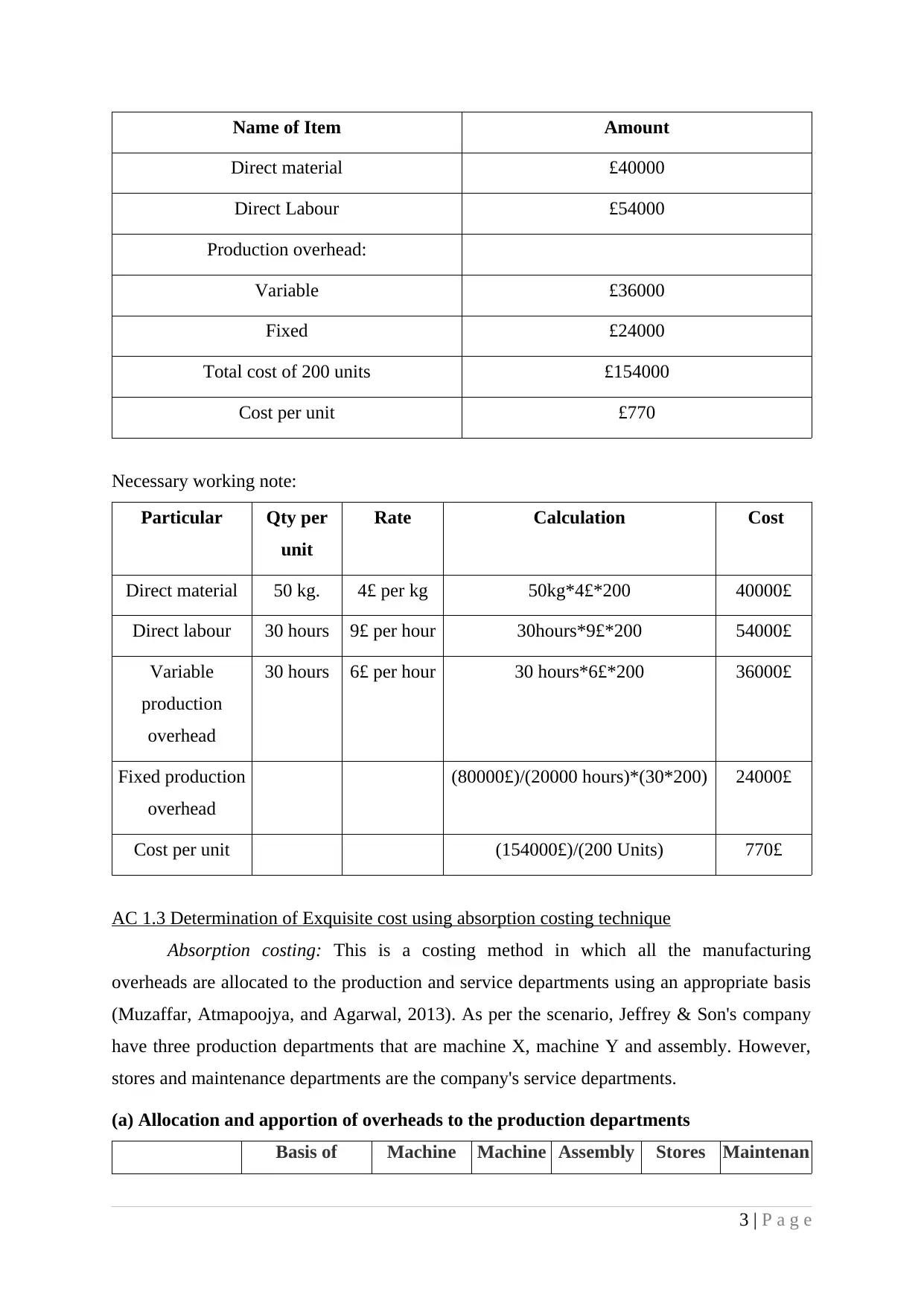
Name of Item Amount
Direct material £40000
Direct Labour £54000
Production overhead:
Variable £36000
Fixed £24000
Total cost of 200 units £154000
Cost per unit £770
Necessary working note:
Particular Qty per
unit
Rate Calculation Cost
Direct material 50 kg. 4£ per kg 50kg*4£*200 40000£
Direct labour 30 hours 9£ per hour 30hours*9£*200 54000£
Variable
production
overhead
30 hours 6£ per hour 30 hours*6£*200 36000£
Fixed production
overhead
(80000£)/(20000 hours)*(30*200) 24000£
Cost per unit (154000£)/(200 Units) 770£
AC 1.3 Determination of Exquisite cost using absorption costing technique
Absorption costing: This is a costing method in which all the manufacturing
overheads are allocated to the production and service departments using an appropriate basis
(Muzaffar, Atmapoojya, and Agarwal, 2013). As per the scenario, Jeffrey & Son's company
have three production departments that are machine X, machine Y and assembly. However,
stores and maintenance departments are the company's service departments.
(a) Allocation and apportion of overheads to the production departments
Basis of Machine Machine Assembly Stores Maintenan
3 | P a g e
Direct material £40000
Direct Labour £54000
Production overhead:
Variable £36000
Fixed £24000
Total cost of 200 units £154000
Cost per unit £770
Necessary working note:
Particular Qty per
unit
Rate Calculation Cost
Direct material 50 kg. 4£ per kg 50kg*4£*200 40000£
Direct labour 30 hours 9£ per hour 30hours*9£*200 54000£
Variable
production
overhead
30 hours 6£ per hour 30 hours*6£*200 36000£
Fixed production
overhead
(80000£)/(20000 hours)*(30*200) 24000£
Cost per unit (154000£)/(200 Units) 770£
AC 1.3 Determination of Exquisite cost using absorption costing technique
Absorption costing: This is a costing method in which all the manufacturing
overheads are allocated to the production and service departments using an appropriate basis
(Muzaffar, Atmapoojya, and Agarwal, 2013). As per the scenario, Jeffrey & Son's company
have three production departments that are machine X, machine Y and assembly. However,
stores and maintenance departments are the company's service departments.
(a) Allocation and apportion of overheads to the production departments
Basis of Machine Machine Assembly Stores Maintenan
3 | P a g e
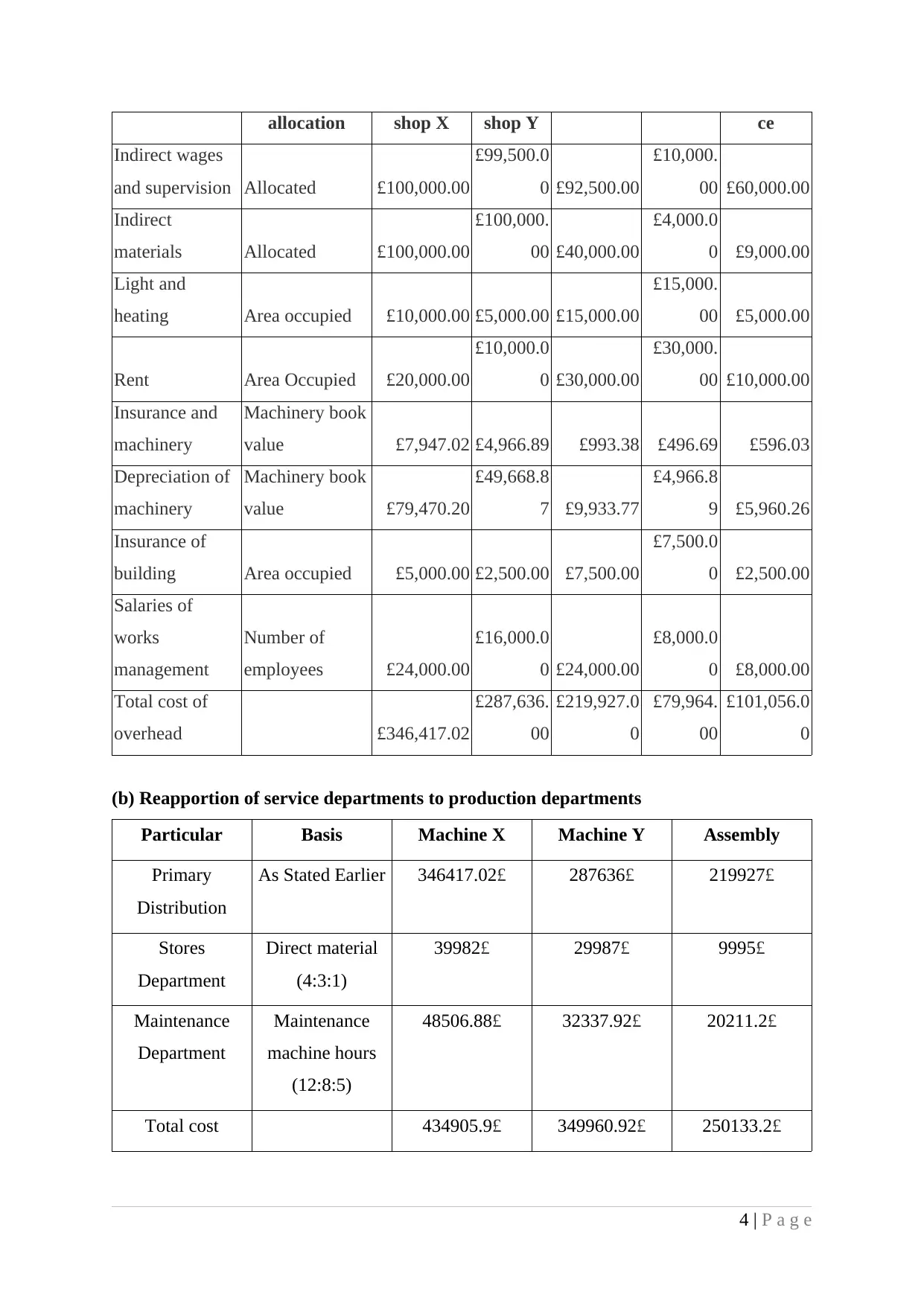
allocation shop X shop Y ce
Indirect wages
and supervision Allocated £100,000.00
£99,500.0
0 £92,500.00
£10,000.
00 £60,000.00
Indirect
materials Allocated £100,000.00
£100,000.
00 £40,000.00
£4,000.0
0 £9,000.00
Light and
heating Area occupied £10,000.00 £5,000.00 £15,000.00
£15,000.
00 £5,000.00
Rent Area Occupied £20,000.00
£10,000.0
0 £30,000.00
£30,000.
00 £10,000.00
Insurance and
machinery
Machinery book
value £7,947.02 £4,966.89 £993.38 £496.69 £596.03
Depreciation of
machinery
Machinery book
value £79,470.20
£49,668.8
7 £9,933.77
£4,966.8
9 £5,960.26
Insurance of
building Area occupied £5,000.00 £2,500.00 £7,500.00
£7,500.0
0 £2,500.00
Salaries of
works
management
Number of
employees £24,000.00
£16,000.0
0 £24,000.00
£8,000.0
0 £8,000.00
Total cost of
overhead £346,417.02
£287,636.
00
£219,927.0
0
£79,964.
00
£101,056.0
0
(b) Reapportion of service departments to production departments
Particular Basis Machine X Machine Y Assembly
Primary
Distribution
As Stated Earlier 346417.02£ 287636£ 219927£
Stores
Department
Direct material
(4:3:1)
39982£ 29987£ 9995£
Maintenance
Department
Maintenance
machine hours
(12:8:5)
48506.88£ 32337.92£ 20211.2£
Total cost 434905.9£ 349960.92£ 250133.2£
4 | P a g e
Indirect wages
and supervision Allocated £100,000.00
£99,500.0
0 £92,500.00
£10,000.
00 £60,000.00
Indirect
materials Allocated £100,000.00
£100,000.
00 £40,000.00
£4,000.0
0 £9,000.00
Light and
heating Area occupied £10,000.00 £5,000.00 £15,000.00
£15,000.
00 £5,000.00
Rent Area Occupied £20,000.00
£10,000.0
0 £30,000.00
£30,000.
00 £10,000.00
Insurance and
machinery
Machinery book
value £7,947.02 £4,966.89 £993.38 £496.69 £596.03
Depreciation of
machinery
Machinery book
value £79,470.20
£49,668.8
7 £9,933.77
£4,966.8
9 £5,960.26
Insurance of
building Area occupied £5,000.00 £2,500.00 £7,500.00
£7,500.0
0 £2,500.00
Salaries of
works
management
Number of
employees £24,000.00
£16,000.0
0 £24,000.00
£8,000.0
0 £8,000.00
Total cost of
overhead £346,417.02
£287,636.
00
£219,927.0
0
£79,964.
00
£101,056.0
0
(b) Reapportion of service departments to production departments
Particular Basis Machine X Machine Y Assembly
Primary
Distribution
As Stated Earlier 346417.02£ 287636£ 219927£
Stores
Department
Direct material
(4:3:1)
39982£ 29987£ 9995£
Maintenance
Department
Maintenance
machine hours
(12:8:5)
48506.88£ 32337.92£ 20211.2£
Total cost 434905.9£ 349960.92£ 250133.2£
4 | P a g e
⊘ This is a preview!⊘
Do you want full access?
Subscribe today to unlock all pages.

Trusted by 1+ million students worldwide
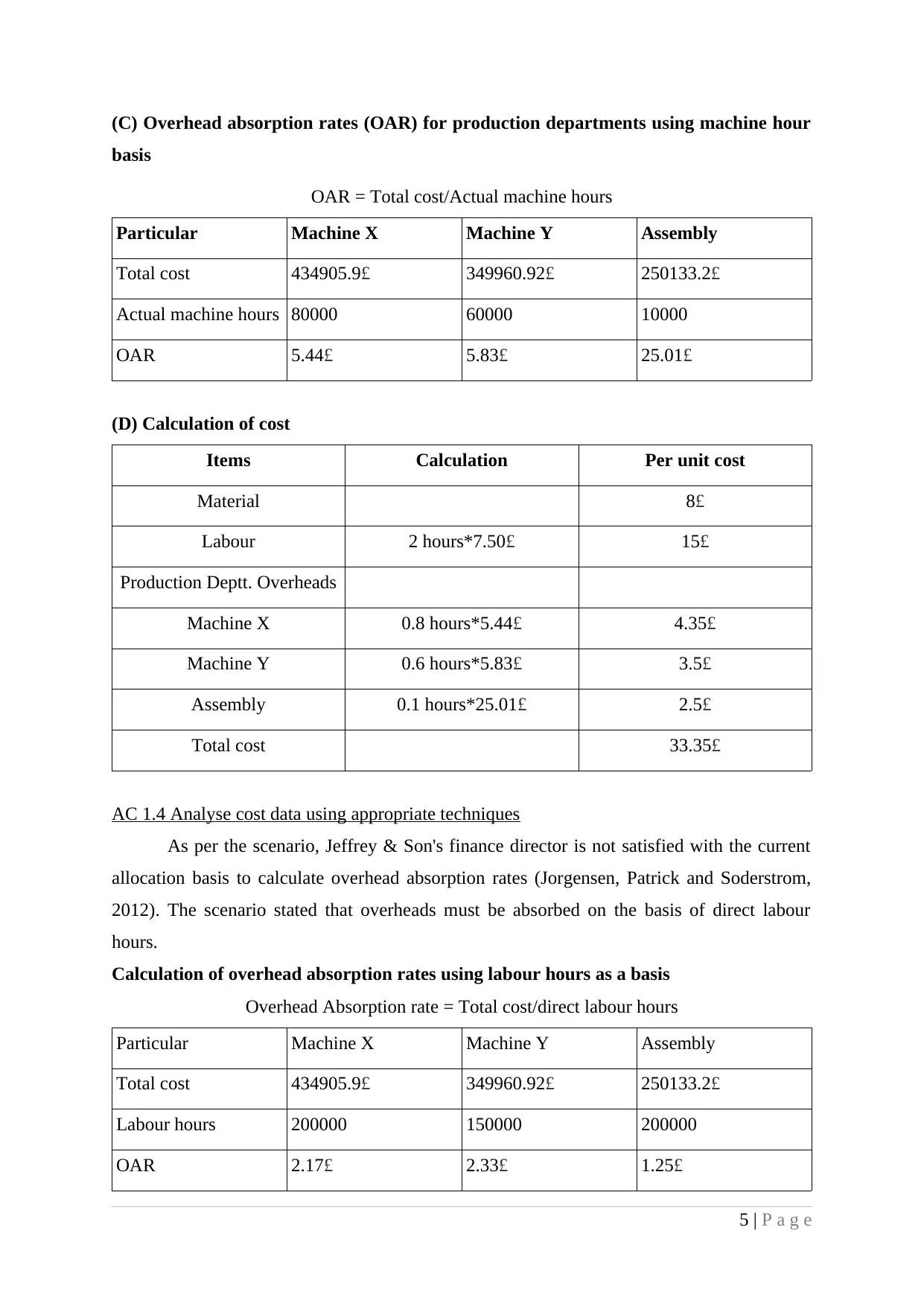
(C) Overhead absorption rates (OAR) for production departments using machine hour
basis
OAR = Total cost/Actual machine hours
Particular Machine X Machine Y Assembly
Total cost 434905.9£ 349960.92£ 250133.2£
Actual machine hours 80000 60000 10000
OAR 5.44£ 5.83£ 25.01£
(D) Calculation of cost
Items Calculation Per unit cost
Material 8£
Labour 2 hours*7.50£ 15£
Production Deptt. Overheads
Machine X 0.8 hours*5.44£ 4.35£
Machine Y 0.6 hours*5.83£ 3.5£
Assembly 0.1 hours*25.01£ 2.5£
Total cost 33.35£
AC 1.4 Analyse cost data using appropriate techniques
As per the scenario, Jeffrey & Son's finance director is not satisfied with the current
allocation basis to calculate overhead absorption rates (Jorgensen, Patrick and Soderstrom,
2012). The scenario stated that overheads must be absorbed on the basis of direct labour
hours.
Calculation of overhead absorption rates using labour hours as a basis
Overhead Absorption rate = Total cost/direct labour hours
Particular Machine X Machine Y Assembly
Total cost 434905.9£ 349960.92£ 250133.2£
Labour hours 200000 150000 200000
OAR 2.17£ 2.33£ 1.25£
5 | P a g e
basis
OAR = Total cost/Actual machine hours
Particular Machine X Machine Y Assembly
Total cost 434905.9£ 349960.92£ 250133.2£
Actual machine hours 80000 60000 10000
OAR 5.44£ 5.83£ 25.01£
(D) Calculation of cost
Items Calculation Per unit cost
Material 8£
Labour 2 hours*7.50£ 15£
Production Deptt. Overheads
Machine X 0.8 hours*5.44£ 4.35£
Machine Y 0.6 hours*5.83£ 3.5£
Assembly 0.1 hours*25.01£ 2.5£
Total cost 33.35£
AC 1.4 Analyse cost data using appropriate techniques
As per the scenario, Jeffrey & Son's finance director is not satisfied with the current
allocation basis to calculate overhead absorption rates (Jorgensen, Patrick and Soderstrom,
2012). The scenario stated that overheads must be absorbed on the basis of direct labour
hours.
Calculation of overhead absorption rates using labour hours as a basis
Overhead Absorption rate = Total cost/direct labour hours
Particular Machine X Machine Y Assembly
Total cost 434905.9£ 349960.92£ 250133.2£
Labour hours 200000 150000 200000
OAR 2.17£ 2.33£ 1.25£
5 | P a g e
Paraphrase This Document
Need a fresh take? Get an instant paraphrase of this document with our AI Paraphraser
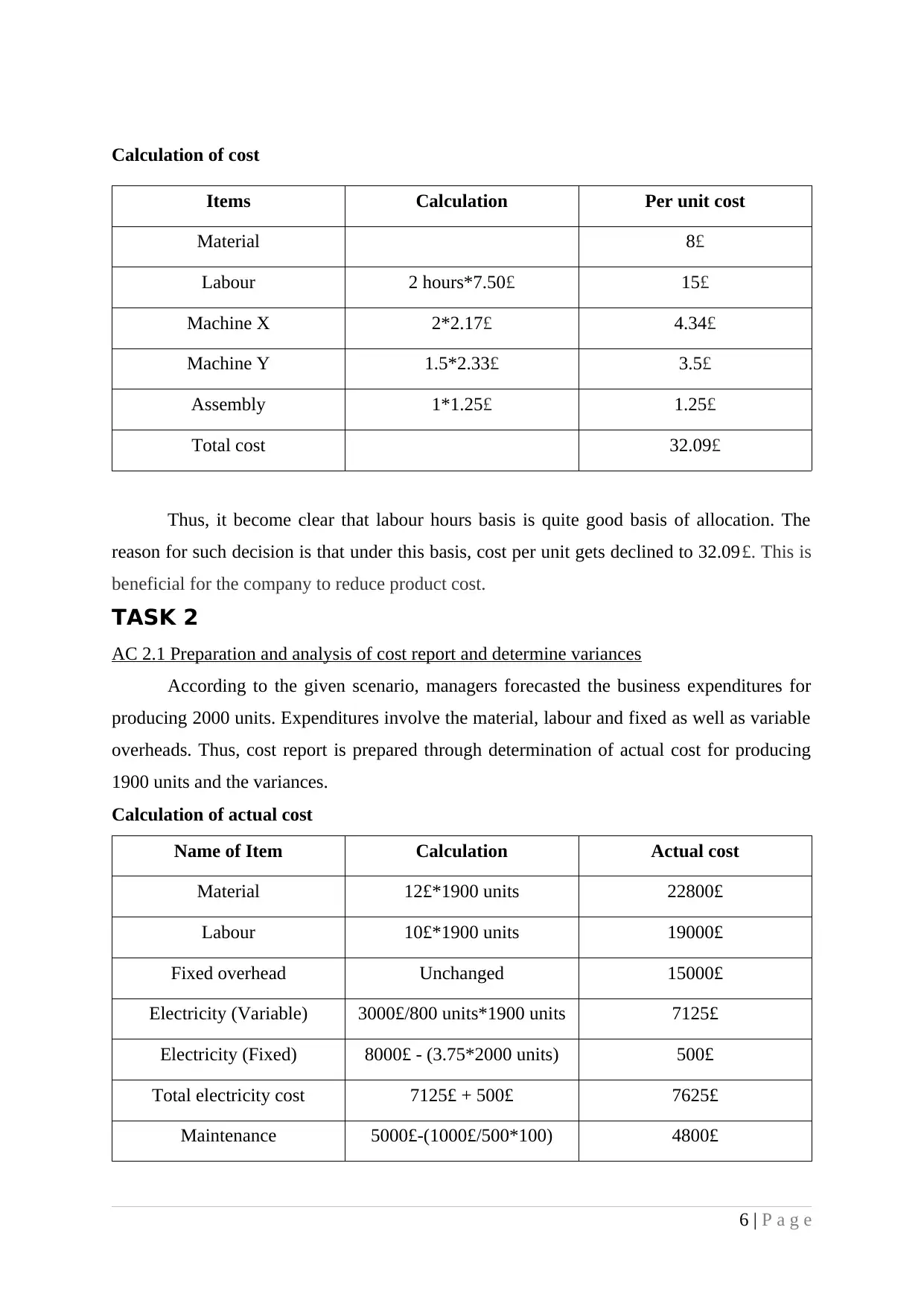
Calculation of cost
Items Calculation Per unit cost
Material 8£
Labour 2 hours*7.50£ 15£
Machine X 2*2.17£ 4.34£
Machine Y 1.5*2.33£ 3.5£
Assembly 1*1.25£ 1.25£
Total cost 32.09£
Thus, it become clear that labour hours basis is quite good basis of allocation. The
reason for such decision is that under this basis, cost per unit gets declined to 32.09£. This is
beneficial for the company to reduce product cost.
TASK 2
AC 2.1 Preparation and analysis of cost report and determine variances
According to the given scenario, managers forecasted the business expenditures for
producing 2000 units. Expenditures involve the material, labour and fixed as well as variable
overheads. Thus, cost report is prepared through determination of actual cost for producing
1900 units and the variances.
Calculation of actual cost
Name of Item Calculation Actual cost
Material 12£*1900 units 22800£
Labour 10£*1900 units 19000£
Fixed overhead Unchanged 15000£
Electricity (Variable) 3000£/800 units*1900 units 7125£
Electricity (Fixed) 8000£ - (3.75*2000 units) 500£
Total electricity cost 7125£ + 500£ 7625£
Maintenance 5000£-(1000£/500*100) 4800£
6 | P a g e
Items Calculation Per unit cost
Material 8£
Labour 2 hours*7.50£ 15£
Machine X 2*2.17£ 4.34£
Machine Y 1.5*2.33£ 3.5£
Assembly 1*1.25£ 1.25£
Total cost 32.09£
Thus, it become clear that labour hours basis is quite good basis of allocation. The
reason for such decision is that under this basis, cost per unit gets declined to 32.09£. This is
beneficial for the company to reduce product cost.
TASK 2
AC 2.1 Preparation and analysis of cost report and determine variances
According to the given scenario, managers forecasted the business expenditures for
producing 2000 units. Expenditures involve the material, labour and fixed as well as variable
overheads. Thus, cost report is prepared through determination of actual cost for producing
1900 units and the variances.
Calculation of actual cost
Name of Item Calculation Actual cost
Material 12£*1900 units 22800£
Labour 10£*1900 units 19000£
Fixed overhead Unchanged 15000£
Electricity (Variable) 3000£/800 units*1900 units 7125£
Electricity (Fixed) 8000£ - (3.75*2000 units) 500£
Total electricity cost 7125£ + 500£ 7625£
Maintenance 5000£-(1000£/500*100) 4800£
6 | P a g e
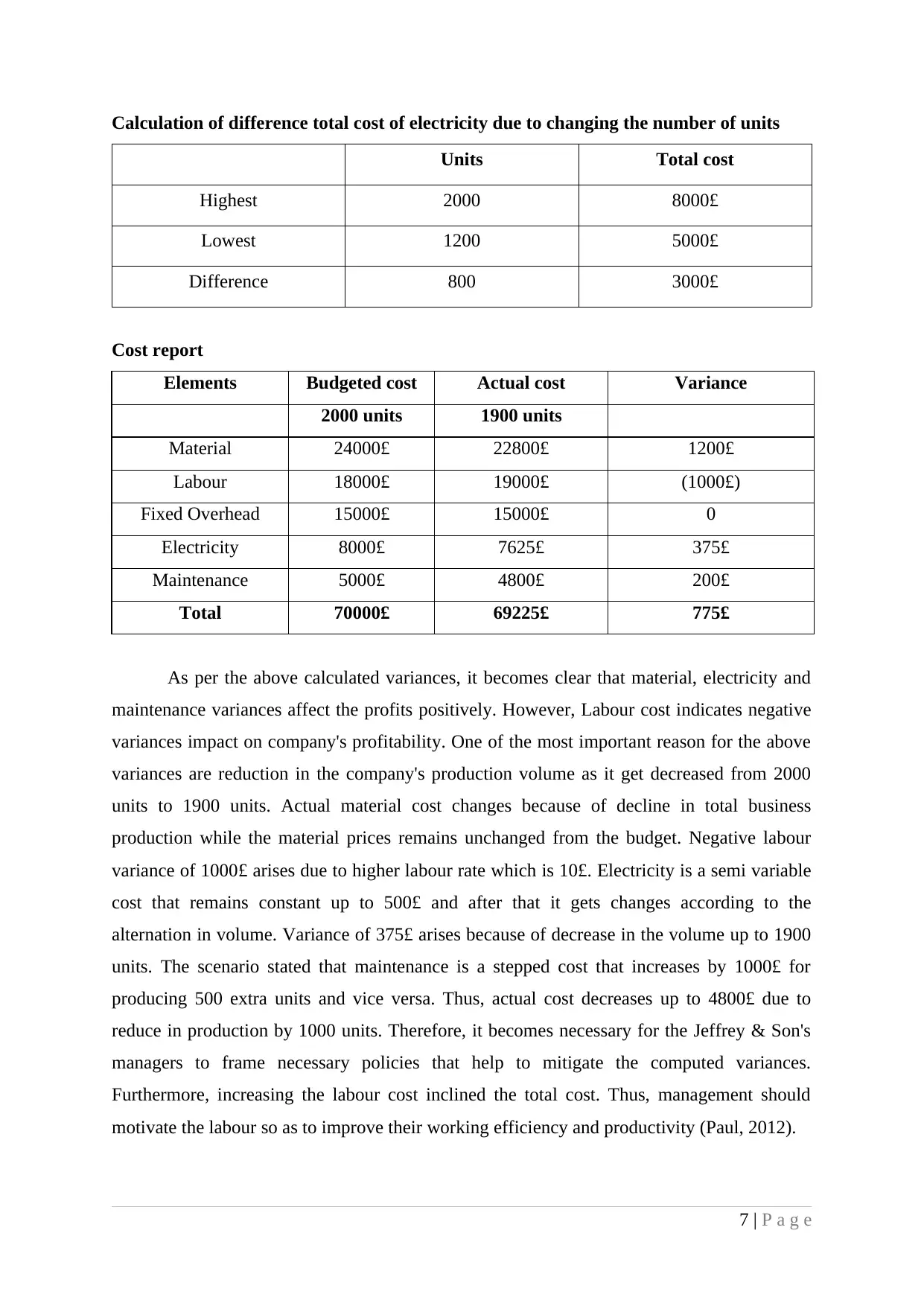
Calculation of difference total cost of electricity due to changing the number of units
Units Total cost
Highest 2000 8000£
Lowest 1200 5000£
Difference 800 3000£
Cost report
Elements Budgeted cost Actual cost Variance
2000 units 1900 units
Material 24000£ 22800£ 1200£
Labour 18000£ 19000£ (1000£)
Fixed Overhead 15000£ 15000£ 0
Electricity 8000£ 7625£ 375£
Maintenance 5000£ 4800£ 200£
Total 70000£ 69225£ 775£
As per the above calculated variances, it becomes clear that material, electricity and
maintenance variances affect the profits positively. However, Labour cost indicates negative
variances impact on company's profitability. One of the most important reason for the above
variances are reduction in the company's production volume as it get decreased from 2000
units to 1900 units. Actual material cost changes because of decline in total business
production while the material prices remains unchanged from the budget. Negative labour
variance of 1000£ arises due to higher labour rate which is 10£. Electricity is a semi variable
cost that remains constant up to 500£ and after that it gets changes according to the
alternation in volume. Variance of 375£ arises because of decrease in the volume up to 1900
units. The scenario stated that maintenance is a stepped cost that increases by 1000£ for
producing 500 extra units and vice versa. Thus, actual cost decreases up to 4800£ due to
reduce in production by 1000 units. Therefore, it becomes necessary for the Jeffrey & Son's
managers to frame necessary policies that help to mitigate the computed variances.
Furthermore, increasing the labour cost inclined the total cost. Thus, management should
motivate the labour so as to improve their working efficiency and productivity (Paul, 2012).
7 | P a g e
Units Total cost
Highest 2000 8000£
Lowest 1200 5000£
Difference 800 3000£
Cost report
Elements Budgeted cost Actual cost Variance
2000 units 1900 units
Material 24000£ 22800£ 1200£
Labour 18000£ 19000£ (1000£)
Fixed Overhead 15000£ 15000£ 0
Electricity 8000£ 7625£ 375£
Maintenance 5000£ 4800£ 200£
Total 70000£ 69225£ 775£
As per the above calculated variances, it becomes clear that material, electricity and
maintenance variances affect the profits positively. However, Labour cost indicates negative
variances impact on company's profitability. One of the most important reason for the above
variances are reduction in the company's production volume as it get decreased from 2000
units to 1900 units. Actual material cost changes because of decline in total business
production while the material prices remains unchanged from the budget. Negative labour
variance of 1000£ arises due to higher labour rate which is 10£. Electricity is a semi variable
cost that remains constant up to 500£ and after that it gets changes according to the
alternation in volume. Variance of 375£ arises because of decrease in the volume up to 1900
units. The scenario stated that maintenance is a stepped cost that increases by 1000£ for
producing 500 extra units and vice versa. Thus, actual cost decreases up to 4800£ due to
reduce in production by 1000 units. Therefore, it becomes necessary for the Jeffrey & Son's
managers to frame necessary policies that help to mitigate the computed variances.
Furthermore, increasing the labour cost inclined the total cost. Thus, management should
motivate the labour so as to improve their working efficiency and productivity (Paul, 2012).
7 | P a g e
⊘ This is a preview!⊘
Do you want full access?
Subscribe today to unlock all pages.

Trusted by 1+ million students worldwide
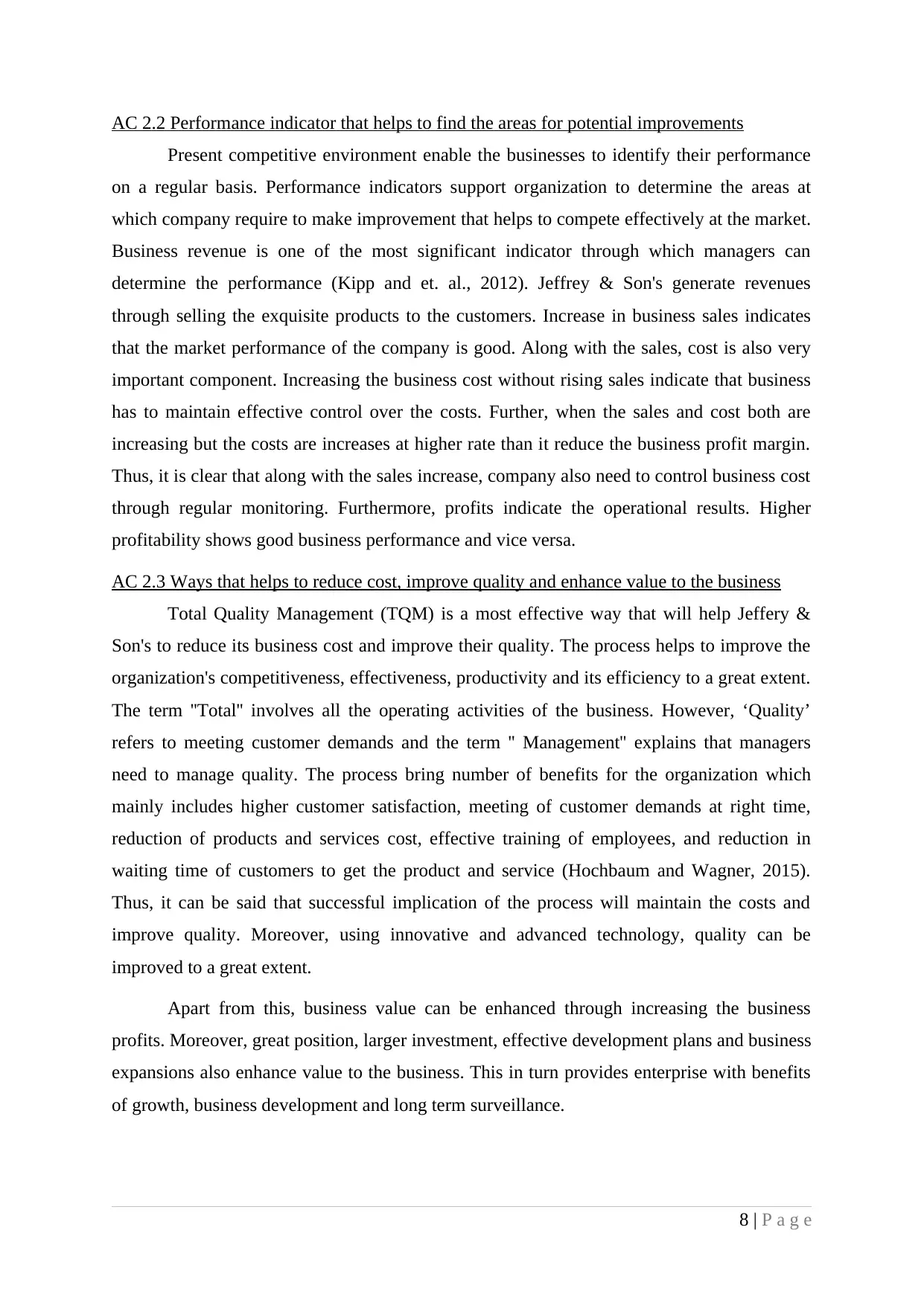
AC 2.2 Performance indicator that helps to find the areas for potential improvements
Present competitive environment enable the businesses to identify their performance
on a regular basis. Performance indicators support organization to determine the areas at
which company require to make improvement that helps to compete effectively at the market.
Business revenue is one of the most significant indicator through which managers can
determine the performance (Kipp and et. al., 2012). Jeffrey & Son's generate revenues
through selling the exquisite products to the customers. Increase in business sales indicates
that the market performance of the company is good. Along with the sales, cost is also very
important component. Increasing the business cost without rising sales indicate that business
has to maintain effective control over the costs. Further, when the sales and cost both are
increasing but the costs are increases at higher rate than it reduce the business profit margin.
Thus, it is clear that along with the sales increase, company also need to control business cost
through regular monitoring. Furthermore, profits indicate the operational results. Higher
profitability shows good business performance and vice versa.
AC 2.3 Ways that helps to reduce cost, improve quality and enhance value to the business
Total Quality Management (TQM) is a most effective way that will help Jeffery &
Son's to reduce its business cost and improve their quality. The process helps to improve the
organization's competitiveness, effectiveness, productivity and its efficiency to a great extent.
The term ''Total'' involves all the operating activities of the business. However, ‘Quality’
refers to meeting customer demands and the term '' Management'' explains that managers
need to manage quality. The process bring number of benefits for the organization which
mainly includes higher customer satisfaction, meeting of customer demands at right time,
reduction of products and services cost, effective training of employees, and reduction in
waiting time of customers to get the product and service (Hochbaum and Wagner, 2015).
Thus, it can be said that successful implication of the process will maintain the costs and
improve quality. Moreover, using innovative and advanced technology, quality can be
improved to a great extent.
Apart from this, business value can be enhanced through increasing the business
profits. Moreover, great position, larger investment, effective development plans and business
expansions also enhance value to the business. This in turn provides enterprise with benefits
of growth, business development and long term surveillance.
8 | P a g e
Present competitive environment enable the businesses to identify their performance
on a regular basis. Performance indicators support organization to determine the areas at
which company require to make improvement that helps to compete effectively at the market.
Business revenue is one of the most significant indicator through which managers can
determine the performance (Kipp and et. al., 2012). Jeffrey & Son's generate revenues
through selling the exquisite products to the customers. Increase in business sales indicates
that the market performance of the company is good. Along with the sales, cost is also very
important component. Increasing the business cost without rising sales indicate that business
has to maintain effective control over the costs. Further, when the sales and cost both are
increasing but the costs are increases at higher rate than it reduce the business profit margin.
Thus, it is clear that along with the sales increase, company also need to control business cost
through regular monitoring. Furthermore, profits indicate the operational results. Higher
profitability shows good business performance and vice versa.
AC 2.3 Ways that helps to reduce cost, improve quality and enhance value to the business
Total Quality Management (TQM) is a most effective way that will help Jeffery &
Son's to reduce its business cost and improve their quality. The process helps to improve the
organization's competitiveness, effectiveness, productivity and its efficiency to a great extent.
The term ''Total'' involves all the operating activities of the business. However, ‘Quality’
refers to meeting customer demands and the term '' Management'' explains that managers
need to manage quality. The process bring number of benefits for the organization which
mainly includes higher customer satisfaction, meeting of customer demands at right time,
reduction of products and services cost, effective training of employees, and reduction in
waiting time of customers to get the product and service (Hochbaum and Wagner, 2015).
Thus, it can be said that successful implication of the process will maintain the costs and
improve quality. Moreover, using innovative and advanced technology, quality can be
improved to a great extent.
Apart from this, business value can be enhanced through increasing the business
profits. Moreover, great position, larger investment, effective development plans and business
expansions also enhance value to the business. This in turn provides enterprise with benefits
of growth, business development and long term surveillance.
8 | P a g e
Paraphrase This Document
Need a fresh take? Get an instant paraphrase of this document with our AI Paraphraser
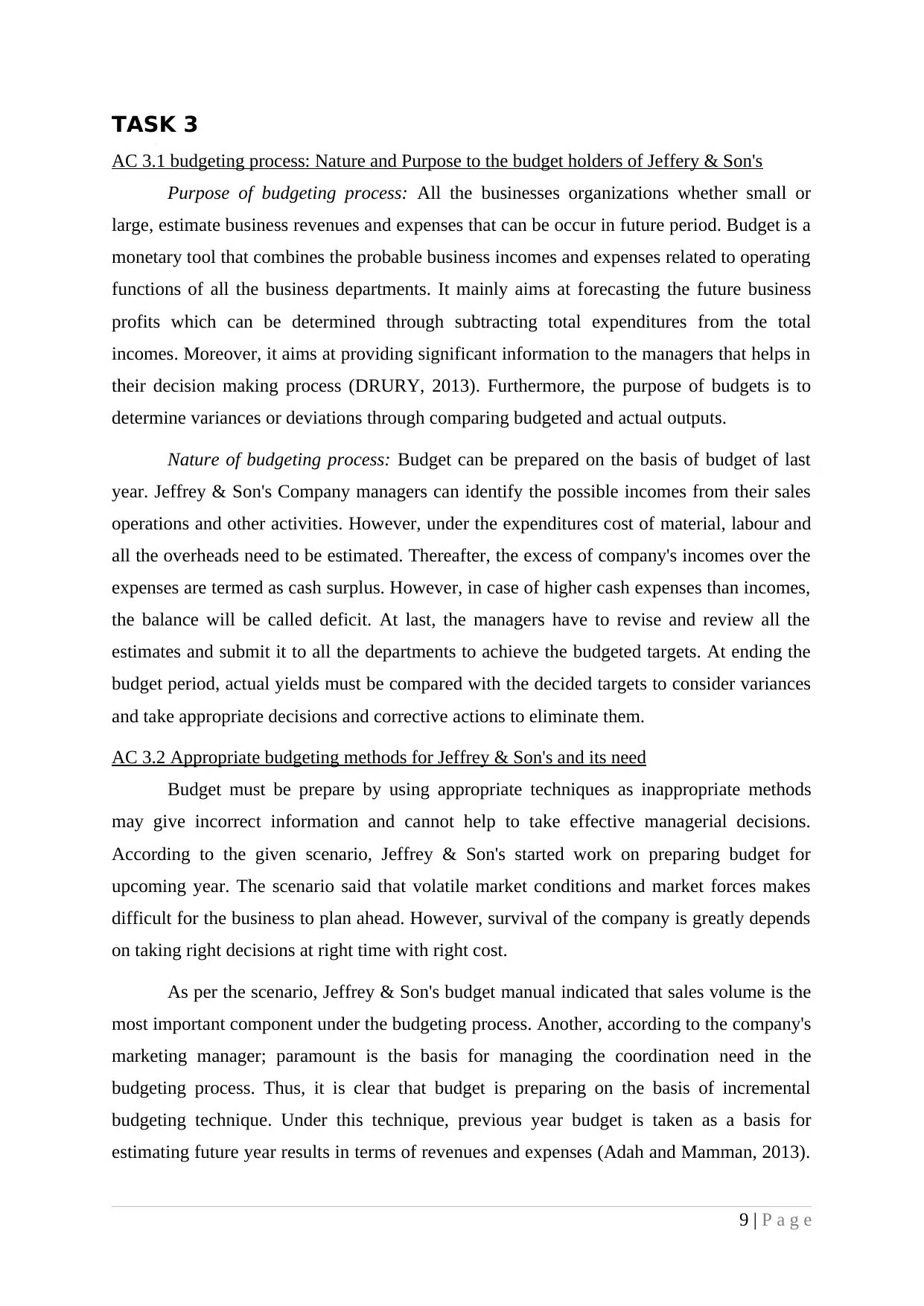
TASK 3
AC 3.1 budgeting process: Nature and Purpose to the budget holders of Jeffery & Son's
Purpose of budgeting process: All the businesses organizations whether small or
large, estimate business revenues and expenses that can be occur in future period. Budget is a
monetary tool that combines the probable business incomes and expenses related to operating
functions of all the business departments. It mainly aims at forecasting the future business
profits which can be determined through subtracting total expenditures from the total
incomes. Moreover, it aims at providing significant information to the managers that helps in
their decision making process (DRURY, 2013). Furthermore, the purpose of budgets is to
determine variances or deviations through comparing budgeted and actual outputs.
Nature of budgeting process: Budget can be prepared on the basis of budget of last
year. Jeffrey & Son's Company managers can identify the possible incomes from their sales
operations and other activities. However, under the expenditures cost of material, labour and
all the overheads need to be estimated. Thereafter, the excess of company's incomes over the
expenses are termed as cash surplus. However, in case of higher cash expenses than incomes,
the balance will be called deficit. At last, the managers have to revise and review all the
estimates and submit it to all the departments to achieve the budgeted targets. At ending the
budget period, actual yields must be compared with the decided targets to consider variances
and take appropriate decisions and corrective actions to eliminate them.
AC 3.2 Appropriate budgeting methods for Jeffrey & Son's and its need
Budget must be prepare by using appropriate techniques as inappropriate methods
may give incorrect information and cannot help to take effective managerial decisions.
According to the given scenario, Jeffrey & Son's started work on preparing budget for
upcoming year. The scenario said that volatile market conditions and market forces makes
difficult for the business to plan ahead. However, survival of the company is greatly depends
on taking right decisions at right time with right cost.
As per the scenario, Jeffrey & Son's budget manual indicated that sales volume is the
most important component under the budgeting process. Another, according to the company's
marketing manager; paramount is the basis for managing the coordination need in the
budgeting process. Thus, it is clear that budget is preparing on the basis of incremental
budgeting technique. Under this technique, previous year budget is taken as a basis for
estimating future year results in terms of revenues and expenses (Adah and Mamman, 2013).
9 | P a g e
AC 3.1 budgeting process: Nature and Purpose to the budget holders of Jeffery & Son's
Purpose of budgeting process: All the businesses organizations whether small or
large, estimate business revenues and expenses that can be occur in future period. Budget is a
monetary tool that combines the probable business incomes and expenses related to operating
functions of all the business departments. It mainly aims at forecasting the future business
profits which can be determined through subtracting total expenditures from the total
incomes. Moreover, it aims at providing significant information to the managers that helps in
their decision making process (DRURY, 2013). Furthermore, the purpose of budgets is to
determine variances or deviations through comparing budgeted and actual outputs.
Nature of budgeting process: Budget can be prepared on the basis of budget of last
year. Jeffrey & Son's Company managers can identify the possible incomes from their sales
operations and other activities. However, under the expenditures cost of material, labour and
all the overheads need to be estimated. Thereafter, the excess of company's incomes over the
expenses are termed as cash surplus. However, in case of higher cash expenses than incomes,
the balance will be called deficit. At last, the managers have to revise and review all the
estimates and submit it to all the departments to achieve the budgeted targets. At ending the
budget period, actual yields must be compared with the decided targets to consider variances
and take appropriate decisions and corrective actions to eliminate them.
AC 3.2 Appropriate budgeting methods for Jeffrey & Son's and its need
Budget must be prepare by using appropriate techniques as inappropriate methods
may give incorrect information and cannot help to take effective managerial decisions.
According to the given scenario, Jeffrey & Son's started work on preparing budget for
upcoming year. The scenario said that volatile market conditions and market forces makes
difficult for the business to plan ahead. However, survival of the company is greatly depends
on taking right decisions at right time with right cost.
As per the scenario, Jeffrey & Son's budget manual indicated that sales volume is the
most important component under the budgeting process. Another, according to the company's
marketing manager; paramount is the basis for managing the coordination need in the
budgeting process. Thus, it is clear that budget is preparing on the basis of incremental
budgeting technique. Under this technique, previous year budget is taken as a basis for
estimating future year results in terms of revenues and expenses (Adah and Mamman, 2013).
9 | P a g e
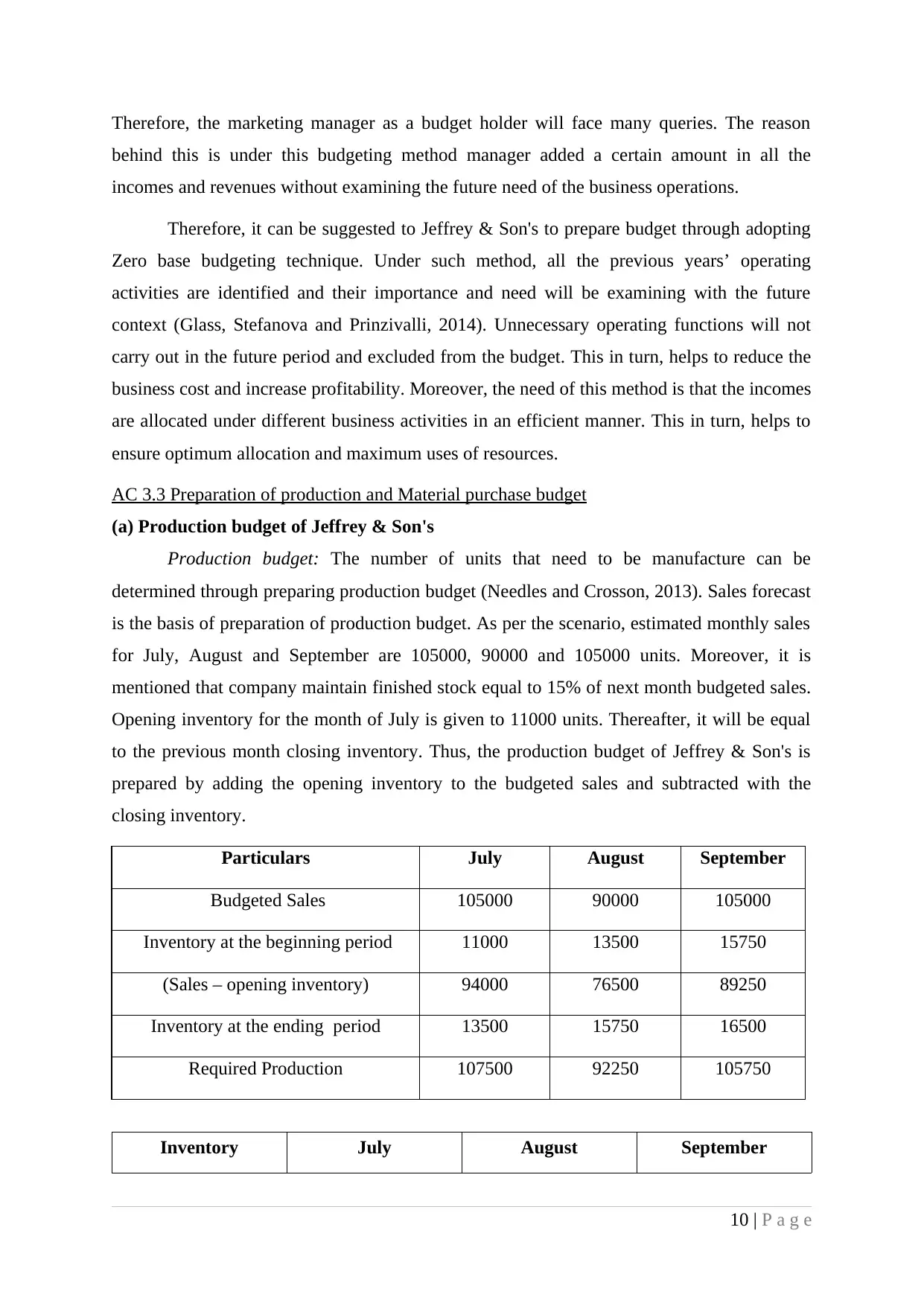
Therefore, the marketing manager as a budget holder will face many queries. The reason
behind this is under this budgeting method manager added a certain amount in all the
incomes and revenues without examining the future need of the business operations.
Therefore, it can be suggested to Jeffrey & Son's to prepare budget through adopting
Zero base budgeting technique. Under such method, all the previous years’ operating
activities are identified and their importance and need will be examining with the future
context (Glass, Stefanova and Prinzivalli, 2014). Unnecessary operating functions will not
carry out in the future period and excluded from the budget. This in turn, helps to reduce the
business cost and increase profitability. Moreover, the need of this method is that the incomes
are allocated under different business activities in an efficient manner. This in turn, helps to
ensure optimum allocation and maximum uses of resources.
AC 3.3 Preparation of production and Material purchase budget
(a) Production budget of Jeffrey & Son's
Production budget: The number of units that need to be manufacture can be
determined through preparing production budget (Needles and Crosson, 2013). Sales forecast
is the basis of preparation of production budget. As per the scenario, estimated monthly sales
for July, August and September are 105000, 90000 and 105000 units. Moreover, it is
mentioned that company maintain finished stock equal to 15% of next month budgeted sales.
Opening inventory for the month of July is given to 11000 units. Thereafter, it will be equal
to the previous month closing inventory. Thus, the production budget of Jeffrey & Son's is
prepared by adding the opening inventory to the budgeted sales and subtracted with the
closing inventory.
Particulars July August September
Budgeted Sales 105000 90000 105000
Inventory at the beginning period 11000 13500 15750
(Sales – opening inventory) 94000 76500 89250
Inventory at the ending period 13500 15750 16500
Required Production 107500 92250 105750
Inventory July August September
10 | P a g e
behind this is under this budgeting method manager added a certain amount in all the
incomes and revenues without examining the future need of the business operations.
Therefore, it can be suggested to Jeffrey & Son's to prepare budget through adopting
Zero base budgeting technique. Under such method, all the previous years’ operating
activities are identified and their importance and need will be examining with the future
context (Glass, Stefanova and Prinzivalli, 2014). Unnecessary operating functions will not
carry out in the future period and excluded from the budget. This in turn, helps to reduce the
business cost and increase profitability. Moreover, the need of this method is that the incomes
are allocated under different business activities in an efficient manner. This in turn, helps to
ensure optimum allocation and maximum uses of resources.
AC 3.3 Preparation of production and Material purchase budget
(a) Production budget of Jeffrey & Son's
Production budget: The number of units that need to be manufacture can be
determined through preparing production budget (Needles and Crosson, 2013). Sales forecast
is the basis of preparation of production budget. As per the scenario, estimated monthly sales
for July, August and September are 105000, 90000 and 105000 units. Moreover, it is
mentioned that company maintain finished stock equal to 15% of next month budgeted sales.
Opening inventory for the month of July is given to 11000 units. Thereafter, it will be equal
to the previous month closing inventory. Thus, the production budget of Jeffrey & Son's is
prepared by adding the opening inventory to the budgeted sales and subtracted with the
closing inventory.
Particulars July August September
Budgeted Sales 105000 90000 105000
Inventory at the beginning period 11000 13500 15750
(Sales – opening inventory) 94000 76500 89250
Inventory at the ending period 13500 15750 16500
Required Production 107500 92250 105750
Inventory July August September
10 | P a g e
⊘ This is a preview!⊘
Do you want full access?
Subscribe today to unlock all pages.

Trusted by 1+ million students worldwide
1 out of 17
Related Documents
Your All-in-One AI-Powered Toolkit for Academic Success.
+13062052269
info@desklib.com
Available 24*7 on WhatsApp / Email
![[object Object]](/_next/static/media/star-bottom.7253800d.svg)
Unlock your academic potential
Copyright © 2020–2025 A2Z Services. All Rights Reserved. Developed and managed by ZUCOL.





